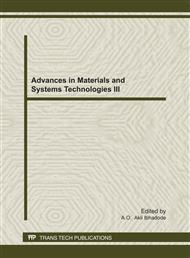p.699
p.711
p.725
p.731
p.739
p.745
p.753
p.779
p.795
Design and Development of an Integrated Small-Scale Oil Palm Fruit Processing Mill
Abstract:
The oil palm (elaeis guneensis) is a very important economic crop in West Africa where it is native. The fruit bunch contains 23 to 30% oil and is the highest yielding of all vegetable oil crops. Palm oil is the second most important vegetable oil in world consumption and the first to be commercialized internationally. Africa and indeed Nigerian was the world’s highest producer of palm oil prior to 1961. Today, Nigeria is the fourth largest producer after Indonesia, Malaysia and Thailand. One of the main reasons given for this fall is lack of efficient mechanized processing equipment for the small-scale producers who produce over 80% of the country’s palm oil. Their methods of production are labour intensive, batch, tedious, inefficient, and produce poor quality oil, have low throughput, unable to extract palm kernel alongside palm oil and so productivity is low and products (palm oil and palm kernel) lack competitiveness. This work has developed a mechanized oil palm fruit processing mill with six fully integrated systems for extracting good quality palm oil and palm kernel, while utilizing process wastes as the main source of heat energy. Each system/unit is expected to operate at the best quoted system efficiency. Tests are ongoing to determine and confirm these efficiencies.
Info:
Periodical:
Pages:
739-743
Citation:
Online since:
October 2011
Keywords:
Price:
Сopyright:
© 2012 Trans Tech Publications Ltd. All Rights Reserved
Share:
Citation:


